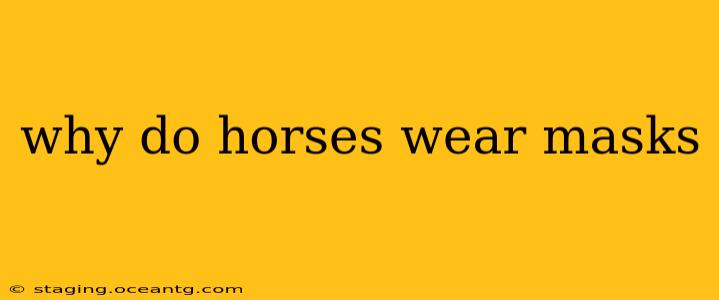Horses wearing masks might seem unusual at first glance, but there are several legitimate reasons why equine athletes and companions might sport this protective gear. From preventing injuries to enhancing performance, understanding the purpose behind these masks can provide valuable insight into equine care. This comprehensive guide delves into the various reasons why horses wear masks, addressing common questions and concerns.
What are the different types of horse masks?
Several types of horse masks cater to different needs. There are fly masks, designed to protect against biting insects and the irritation they cause. These often cover the entire head, ears, and sometimes even the face, offering complete protection. Then there are nose nets, which specifically target the sensitive area around the nostrils and mouth, preventing flies and other insects from bothering the horse. Finally, there are therapeutic masks, used for specific health conditions, which we'll discuss further below. The material varies, too, with lightweight mesh, heavier fabric, and even specialized materials offering UV protection.
What are the benefits of using a fly mask on a horse?
Fly masks are perhaps the most common type of equine mask. Their primary benefit is protection from flies, mosquitoes, and other insects. These pests can be incredibly irritating, causing horses to constantly swat at their faces, potentially leading to injury and reducing their ability to graze or rest peacefully. A fly mask effectively minimizes these distractions and helps maintain a horse's comfort and overall well-being. Many fly masks also offer UV protection, shielding the horse's sensitive skin from harmful sun rays.
Do horses need masks in the winter?
While fly masks are primarily for summer protection, some horses might benefit from wearing a winter mask in certain climates or situations. These masks aren't designed to prevent insect bites but rather to offer protection from cold winds, snow, or rain. They can help keep a horse's face warm and dry, reducing the risk of chapped skin or other weather-related discomfort.
How do I choose the right mask for my horse?
Choosing the right mask involves considering several factors. Fit is crucial; a mask that's too tight can restrict breathing or cause irritation, while a mask that's too loose may not offer adequate protection. The material should also be considered. Mesh offers good airflow and breathability, while heavier fabrics offer more protection from the elements. Consider your horse's individual needs: if they're particularly prone to insect bites, a full-face fly mask might be necessary. If they're sensitive to certain materials, opt for a breathable, hypoallergenic alternative.
Can masks help prevent eye injuries in horses?
While some masks offer some level of protection around the eyes, they're not specifically designed for this purpose. Eye injuries are better prevented through proper handling, environmental safety, and the use of specialized eye protection such as fly goggles, when needed. Relying solely on a standard mask for eye protection would be inadequate.
What about therapeutic masks for horses?
Therapeutic masks are used for specific medical purposes, such as treating skin conditions or wounds around the face. These are often prescribed by a veterinarian and might incorporate special materials or medication. They're not a common sight and are designed for a very specific therapeutic purpose, unlike general-purpose fly masks.
Do horses get used to wearing masks?
Most horses adapt readily to wearing masks, especially fly masks, provided the fit is comfortable. Introducing the mask gradually and offering positive reinforcement can help. Regularly check for any signs of irritation or discomfort; if issues arise, adjust the mask or consult your veterinarian.
In conclusion, the use of masks for horses is a practical measure for various reasons, ranging from basic comfort and protection from insects to therapeutic interventions. Understanding the different types and purposes of equine masks is vital for horse owners seeking to ensure their horse's well-being and optimal performance. By carefully considering factors like fit, material, and intended use, you can provide your equine companion with the appropriate level of protection and comfort.
